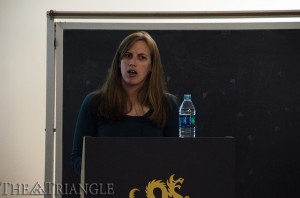
As part of the College of Arts and Sciences Dean’s Seminar series, Erin Graham, an assistant professor of political science and new member of the Department of History and Politics, discussed her research into the structure of international organizations and the changing nature of the United Nations May 8.
“The purpose of these seminars is for the college to understand the research of the new faculty who have joined us,” Donna Murasko, dean of the College of Arts and Sciences, said. “What’s interesting today about the topic is that I think we all think about the U.N. in a kind of idealized form. And Dr. Graham gives us a different perspective on how the U.N. may be looked at today.”
The seminar was titled “The Bilateralization of the United Nations” and challenged the conventional wisdom about the governance structure of the U.N., the notion that it is primarily a multilateral organization that makes collaborative decisions among the member states.
“U.N. activity is becoming detached from these multilateral governing bodies that we so often associate with the United Nations,” Graham said. “And I follow a couple other people in referring to this process as a bilateralization, where multilateral bodies like the general assembly or the executive board of the United Nations Development Programme are ceding control to donors that contract individually with a U.N. agency.”
The original funding source for the U.N. and its agencies was mandatory contributions from the member states, based on their ability to pay. This system is still in place but is now dwarfed by voluntary contributions. These voluntary funds from states and nonstate organizations can be earmarked for, or away from, specific projects. This financing scheme, cooked up at the beginning of the Cold War, allowed countries to support or avoid programs depending on their national interests.
This type of restricted funding has become extremely common, to the point where the two largest contributors to U.N. funding, the United States and the European Commission, restrict 83 percent and 92 percent of their contributions, respectively.
This method of funding programs poses real risks to the legitimacy of the U.N. as an international body. With voluntary funding comes the implicit pressure for U.N. agencies to do what is popular or risk losing their funding.
The World Health Organization, for example, gets lots of restricted funding to fight malaria and AIDS, but those aren’t the only public-health crises facing the world. Restricted funding only makes agencies accountable to individual donors, not to the broader international community.
“A great way to hold a U.N. agency accountable is by virtue of providing or denying them resources. This is a resource-scarce environment. In a bilateral governance structure, it’s going to be a lot easier to exert influence commensurate with your financial contribution. You’re not one among 193 U.N. states. Suddenly if you provide 25 percent of the budget, [the U.N. agency] is going to be listening to what you say,” Graham said.
While restricted voluntary funding has drawbacks, it has been the lifeblood of the U.N. for years and helped overcome what would have been a very serious financing problem otherwise.
“One of the really positive things about this system is it means more money for the U.N. Had they not come up with the idea of voluntary resources at the U.N., the developed nations would have stopped giving money a long time ago,” Graham said. “The innovation of voluntary funding really allows the United Nations to thrive.”
Graham joined Drexel’s faculty in the fall of 2012 after spending time as a postdoctoral fellow at Princeton University’s Niehaus Center for Globalization and Governance. Graham earned her doctorate from The Ohio State University.
The College of Arts and Sciences hosts the Dean’s Seminar series every other Wednesday. The next topic will be “From Repairing the Brain to Connecting the Brain: Astrocytes are Bystanders No More,” presented May 22 by A. Denise Garcia, an associate professor of biology.
The post UN shifts from traditional model appeared first on The Triangle.
